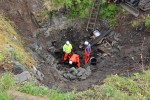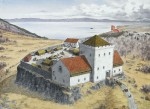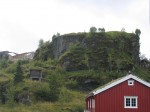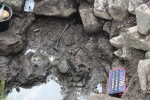 On November 17th, 2014, archaeologists from The Norwegian Institute for Cultural Heritage Research unearthed a skeleton at the bottom of a well on the grounds of Sverresborg, the castle of King Sverre Sigurdsson of Norway (r. 1177–1202). Bones had been found there before in 1938, but they weren’t removed or studied. The well was refilled to preserve the remains. Then World War II and the German occupation of the area blocked further archaeological investigation. The 2014 dig was the first time archaeologists returned to the spot in the hope there was still something left to excavate. There was.
On November 17th, 2014, archaeologists from The Norwegian Institute for Cultural Heritage Research unearthed a skeleton at the bottom of a well on the grounds of Sverresborg, the castle of King Sverre Sigurdsson of Norway (r. 1177–1202). Bones had been found there before in 1938, but they weren’t removed or studied. The well was refilled to preserve the remains. Then World War II and the German occupation of the area blocked further archaeological investigation. The 2014 dig was the first time archaeologists returned to the spot in the hope there was still something left to excavate. There was.
The location of the remains was notable because it matched a story in the Sverris Saga, one of a series of sagas that recount the lives of historic kings of Norway. There are few other sources for the history of this period, so any evidence that might corroborate one the accounts in the Kings’ sagas is exciting.
 From 1130 to 1240, Norway was gripped by civil wars in which pretenders and puppets of various factions vied for the throne. Sverre claimed the throne on the grounds that he was the illegitimate son of King Sigurd II Haraldsson who was killed by his brother in 1155. Magnus V Erlingsson had been installed as king in 1161 when he was five years old. His father Erling Skakke held the real power when his son was a child and after he’d reached his majority, fighting off pretenders with even more tenuous claims than Sverre’s.
From 1130 to 1240, Norway was gripped by civil wars in which pretenders and puppets of various factions vied for the throne. Sverre claimed the throne on the grounds that he was the illegitimate son of King Sigurd II Haraldsson who was killed by his brother in 1155. Magnus V Erlingsson had been installed as king in 1161 when he was five years old. His father Erling Skakke held the real power when his son was a child and after he’d reached his majority, fighting off pretenders with even more tenuous claims than Sverre’s.
Supported by Swedish earls and a Norwegian rebel party known as the Birkebeiner (birch bark shoe-wearers), Sverre challenged Magnus and in 1177 declared himself king. The king and his father begged to differ, however, and it took another seven years before Magnus was finally defeated and killed in the Battle of Fimreite on June 15th, 1184, and Sverre was elected king.
 Sverre and the Birkebeiner were proponents of a strong centralized monarchy that brought the Church to heel as well as secular potentates. His choice to build Sverresborg on a plateau in the city of Nidaros (modern-day Trondheim), see of the archdiocese and center of Christian Norway, was a pointed one. The Archbishop of Nidaros, Eysteinn Erlendsson, had fled to England in 1180 and remained there until 1183. Sverre took advantage of his absence to build the castle. Conflict between the archdiocese and the king was abated for a few years only to flare up again in 1188 with Eysteinn’s death and the appointment of Eirik Ivarsson as his replacement.
Sverre and the Birkebeiner were proponents of a strong centralized monarchy that brought the Church to heel as well as secular potentates. His choice to build Sverresborg on a plateau in the city of Nidaros (modern-day Trondheim), see of the archdiocese and center of Christian Norway, was a pointed one. The Archbishop of Nidaros, Eysteinn Erlendsson, had fled to England in 1180 and remained there until 1183. Sverre took advantage of his absence to build the castle. Conflict between the archdiocese and the king was abated for a few years only to flare up again in 1188 with Eysteinn’s death and the appointment of Eirik Ivarsson as his replacement.
 Conflict between the Church and its supporters and the king and his supporters continued throughout Sverre’s reign. In 1197, a pro-Church faction that would later become known as the Baglers attacked Sverresborg when Sverre was wintering in Bergen after a successful but costly assault on Oslo. The small garrison of about 80 men held the castle thanks to its excellent defensive position, but their commander turned coat and let the enemy into Sverresborg.
Conflict between the Church and its supporters and the king and his supporters continued throughout Sverre’s reign. In 1197, a pro-Church faction that would later become known as the Baglers attacked Sverresborg when Sverre was wintering in Bergen after a successful but costly assault on Oslo. The small garrison of about 80 men held the castle thanks to its excellent defensive position, but their commander turned coat and let the enemy into Sverresborg.
The event is described in the Sverris Saga:
The [Baglers] seized all the property in the castle, and then they burnt every building of it. They took a dead man and cast into the well, and then filled it up with stones. Before they left the castle they called upon the townsmen to break down all the stone walls; and before they marched from the town they burnt all the King’s long-ships. After this they returned to the Uplands, well pleased with the booty they had gained in their journey.
 The skeletal remains found at the bottom of the well in 2014 were indeed covered with stones, just as the saga said. A fragment of bone recovered from the site was radiocarbon dated and found to be about 800 years old, so just the right age to match the story of the Baglers poisoning the castle’s water supply with a dead body. Analysis of the bones indicated they belonged to a man of about 30-40 years of age when he died.
The skeletal remains found at the bottom of the well in 2014 were indeed covered with stones, just as the saga said. A fragment of bone recovered from the site was radiocarbon dated and found to be about 800 years old, so just the right age to match the story of the Baglers poisoning the castle’s water supply with a dead body. Analysis of the bones indicated they belonged to a man of about 30-40 years of age when he died.
Now the Norwegian Institute for Cultural Heritage Research has returned to the site to fully excavate the well and the entire skeleton.
The excavation of the stone debris down to the very first stone that hit the Birkebeiner’s body has given the archaeologists additional insight into the nature of events in 1197. In addition, it exposed the timber posts and lining for the large castle well. […]
“This is truly astonishing. As far as I know there is no known example of the discovery of an individual historically connected with an act of war as far back as the year 1197. And the fact that this actually corroborates an event described in Sverre’s saga is simply amazing,” says lead archaeologist at the site, Anna Petersén.